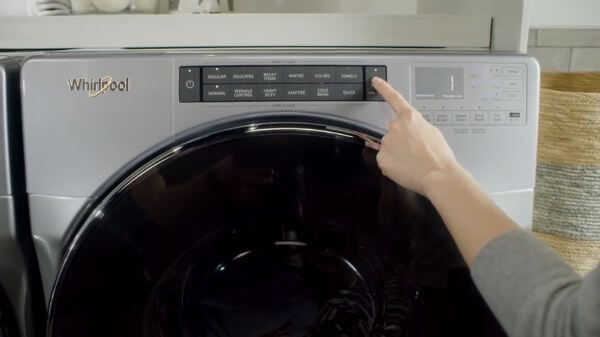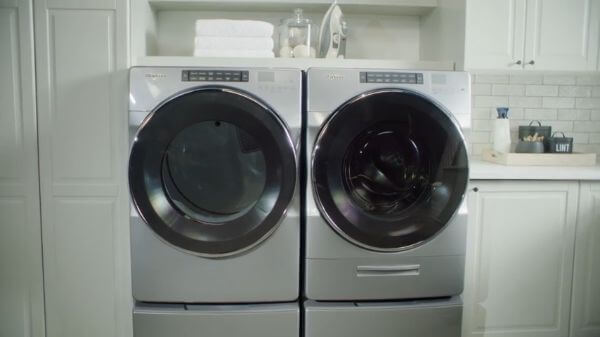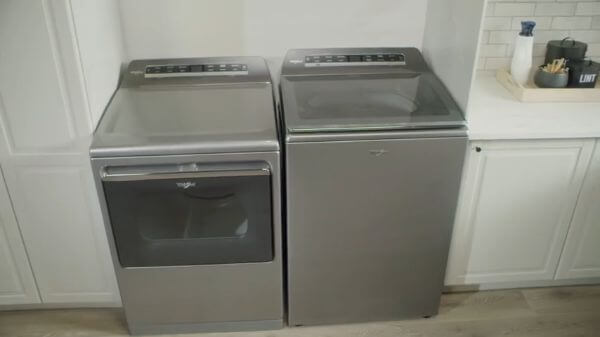Looking for a washing machine that can power through many loads? This buying guide is made for you!
Shopping for a new washing machine that can handle load after load of nasty laundry while still being kind on your delicates?
Here’s everything you need to know about it.
When buying a washing machine, consider the following factors:
- budget and available space
- washer types
- features available
- installation issues
Table of Contents
Questions to Ask
Begin by asking yourself several questions to discover which type of washer is best for your household.
Do you want to buy simply a washer or need you replace your dryer as well?
Buying a washer and dryer together can save you money because laundry combos are frequently discounted. When making a budget, keep this in mind.
How much space does your laundry room have?
If you have enough space to place your laundry pair side by side, consider about where you want it to go.
Consider items like foot traffic, task space, and door swing clearance.
If you have a small space in your house, a stacked front load washer dryer setup can be a good option.
The dryer, which is lighter, is installed above the washer in this configuration.
A stacked laundry center, which merges the washer and dryer into one body or frame, with a front loading dryer above a top loading washer, is another alternative.
Both gas and electric versions of these devices are available.
Stacked laundry centers, which are normally 74 to 76 inches high by 24 to 28 inches wide and 27 to 33 inches deep, are an excellent choice for apartments and condos. That would easily fit in a closet.
Do you have even less space?
Then an all-in-one washer dryer might be the best alternative for you. This machine does both washing and drying and is excellent for small spaces such as bathrooms or closets.
It may be installed almost anyplace because it is ventless, which means it does not require a vent to the outside.
Consider Whirlpool’s smart all-in-one washer and dryer if this choice appeals to you. It not only saves space but also streamlines the laundry process.
Another consideration is washer capacity.
Do you come from a big family? Then a washer with higher capacity might be more useful.
Greater laundry per load means more capacity.
Or do you have a small household? If this is the case, or if you live in a smaller space, a smaller capacity washer may be preferable.
The last planning question to consider is how frequently my household does laundry.
The frequency with which you do your laundry can have an impact on the quality of your clothes, as well as your utility expenses and water efficiency.
The good news is that many machines are energy star certified, which means they consume less water and power to operate.
Types of Washers
There are two types of washing machines: front load and top load.
Front Load Washers
To combat stains, front-load washers employ moderate rotations. A direct drive motor is generally included to aid in achieving and maintaining high spin out speeds during the relevant cycles.
Front load washers set the standard for great efficiency. They can help you save money on detergent while also conserving water.
Although they require longer wash times, their high spin out speeds drain away more moisture, resulting in faster drying times.
Front load washers are more expensive than top load washers, but they are more energy efficient.
Side by side with the dryer, stacked with a dryer on top, or under a countertop with a work surface above are all alternatives for front load machines. This design provides additional space for storage or folding clothes.
A front load washer’s capacity typically ranges from 5 to 5.8 cubic feet.
A standard front load washer measures 38 to 43 inches tall, with a width of around 27 inches and a depth of 28 to 34 inches.
Compact washers range in capacity from 2.1 to 2.6 cubic feet and have a width of roughly 24 inches.
As previously stated, front load washer dryer couples provide a variety of installation options.
Stacked side by side under a counter worktop
A common space-saving approach involves stacking your front-load dryer on top of your front-load washer.
These machines are typically thinner and smaller to fit into a smaller space, such as a closet.
A space of 80 inches high by 28 inches wide by 31 to 34 inches deep is normally required for full-size stackable washers and dryers.
Before beginning any task, always review and follow the use and care instructions for your appliance and product, since they should be your primary source of information.
You may require additional accessories whether you stack your washer and dryer or install them side by side.
A stacking kit will be required to stack your washer and dryer.
Metal brackets are included in these kits to assist stabilize the dryer and ensure it sits securely on top of the washer.
Because the dryer is usually lighter than the washer, it should always be on top.
When used, stacking kits absorb vibrations and reduce noise. Apartment condos and condo dwellers will gain from this.
If there is a pedestal underneath, stacking is not suggested due to the weight of the washer and dryer.
In side-by-side front load washer dryer configurations, pedestals are sometimes used. They are normally sold individually and are used to raise each machine.
A pedestal may raise your machine up to 16 inches. Keep in mind that the height is fixed.
This can make loading and unloading more convenient. Many pedestals contain drawers, which can be used to expand the storage capacity of your laundry room or hide laundry detergent.
Pedestals are available in a variety of sizes, and not all models are compatible with them. Before you start, double-check your measurements and compatibility.
Top Load Washers
Let’s move on to the other main type of washer now that we’ve covered the basics of front load washers.
Top-load washers differ in price from low-cost value washers to high-end models with features like as higher capacity, wi-fi connectivity, and steam cleaning, to mention a few.
They can be more convenient to use because you can load the washer from the top and avoid bending over. However, depending on your height, grabbing items from the bottom of the washer may be more difficult.
To circulate laundry inside the tub, top-load washers employ either an agitator or an impeller.
A tall vertical spindle in the middle of the washer is known as an agitator. It fights stains and loosens grime by physically rubbing against each piece of clothing.
Wash times are usually shorter with agitators. However, this is dependent on the soil level chosen. For individuals who like additional water to assist break down loose dirt, deep water wash choices are available.
Low-profile cones, wheels, fins, or discs rotate and softly rub against each other in impeller design washers.
This design uses only a little amount of water to transport laundry from the outer rim of the wash basket to the center, maximizing friction.
A washer with an agitator uses more motion and water than one with an impeller. These types have more space for bulkier goods and are easier to load and unload because there is no spindle in the middle of the tub.
Their fast spin speeds also cut down on drying time.
Both types have energy star certified models that use less electricity and water than ordinary washers.
Don’t forget to evaluate size and capacity when looking into top-load washers. The most common capacities are 4.2 to 6.1 cubic feet.
A top load washer’s usual height is 42 to 43 inches, with a width of 27 to 27.5 inches and a depth of 25 to 28 inches.
Features
By now, you should have a good notion of what sort of washer is best for you and your family.
So, let’s take a closer look at washing machine features.
These features are available on the market, although not every front load or top load washing machine has them.
Let’s start with the stage.
Some front-load washers offer a cycle that allows you to tumble dry your clothes while they’re in the washer.
Choose front load. A fan fresh option is available on Whirlpool washers. After the wash cycle is completed, a built-in fan turns on.
Tumble clothes for up to 12 hours so you can finish laundry whenever you want.
Some versions have features that help you save time by distributing detergent automatically.
This feature determines the amount of detergent required, removing any doubt about the correct amount.
It also eliminates the inconvenience of having to add detergent to each load.
The load and go dispenser is available on some Whirlpool top and front load washers, allowing you to add detergent once and skip refills for 20 to 40 loads, depending on the model.
Some top-load washers have a water station where you can soak your clothes in either plain water or detergent-infused water.
This allows you to fix stains before putting your laundry in the wash.
With a built-in dual temperature faucet and brush, certain Whirlpool top load washers include a pre-treat station where you can soak, scrub, and wash all in one place directly in the washer tub.
A smart gadget can now be connected to some washers and dryers. You can monitor your wash cycle even when you’re not at home thanks to its connectivity.
Smart features on some Whirlpool washers allow you to connect via the Whirlpool app to start or stop the wash cycle and track progress while you’re gone.
You may also transmit voice commands to your whirlpool smart washer using a Google assistant-enabled device. Whatever it is that you have on your hands.
Many new machines come with a number of different cycles to ensure that your clothes are thoroughly cleaned.
A standard washer detects the soil level and adjusts the settings accordingly, including pre-soak, deep heavy clean, quick wash time, and even sensitive settings.
More than just hot and cold settings are now available on machines.
Warm temperature settings are available, as well as the ability to select different wash and rinse temperature combinations.
Hot-cold, warm-warm, or even warm-cold are some examples.
Sanitized cycles on some machines employ unusually hot water temperatures to kill high percentages of typical household microorganisms.
Load sensing is another feature worth consideration. The washer will detect the load size and calculate the appropriate settings to use. This feature might help you save time by eliminating guesswork from the washing process.
Installation
Installation is a final consideration before you make your purchase.
To begin, double-check that you have enough space for your desired washer and dryer. setup.
To help you measure your space, follow these instructions.
1. Choose a setup.
For front load machines only, place them side by side, stacked, or on pedestals.
2. Take into account the amount of space available.
To make loading and unloading easier, you’ll need around four feet in front of the laundry pair.
Check both the appliance and the room door’s door swing requirements. Allow for hoses and venting space by adding six inches behind the machines. Add one inch on each side of the unit to reduce noise.
Add some extra space above the washer for simple lid opening and shutting if you’re considering a top load washer.
3. Measure the laundry room’s height, length, and width.
If you decide to buy appliance pedestals separately, factor in the extra height.
4. Determine the best route from your front door to the appliance installation site.
This is critical since you’ll need to fit sure your newly purchased machine fits through every hall and doorway on the way to your laundry space.
Before beginning any task, always review and follow the use and care instructions for your appliance and product, since they should be your primary source of information.
Will you be installing your own washer or laundry set, or will you engage a professional? Always study your appliance installation guide for all electrical requirements if you plan to do it yourself. Also, double-check that the intake and drain hoses are installed properly.
If you want a licensed professional to install your new washer or washer dryer set, make sure the space surrounding the machine is clear.
Also, make sure the professional has access to the exact parts and installation instructions.
From tackling load after load of your family’s laundry to removing the uncertainty out of wash cycles, the correct washer can make life so much easier.
You’ll be delighted you picked the right machine for your household.
All Natural Laundry Detergent Sheets



